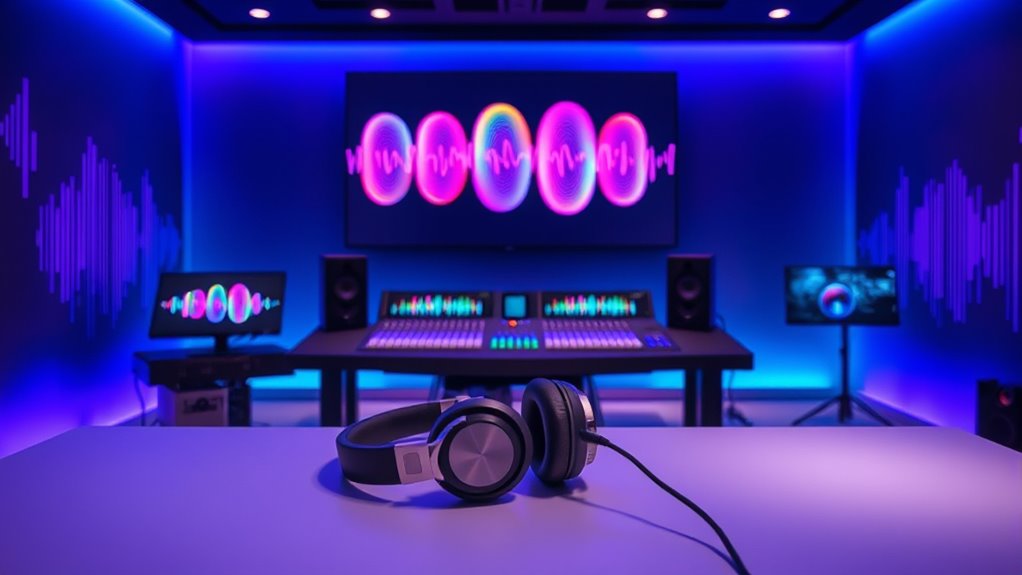Sonic branding involves creating distinctive sounds that become a recognizable part of your brand’s identity, like jingles, sound logos, or brand anthems. You use these audio elements consistently across platforms to strengthen recognition and evoke emotional connections. By aligning sounds with your brand’s personality, you make your brand memorable and engaging. If you want to discover how to craft these powerful audio signatures that resonate, there’s more to explore right here.
Key Takeaways
- Sonic branding creates recognizable audio signatures like jingles and sound logos to reinforce brand identity.
- Consistent use of sound elements across platforms enhances brand recognition and emotional connection.
- Aligning audio with brand values and personality ensures authenticity and relevance.
- Incorporating trending sounds and cultural sensitivities helps maintain relevance and virality.
- Well-crafted sonic identities foster loyalty and deepen consumer engagement through memorable auditory experiences.

Sonic branding is a powerful strategy that uses sound to strengthen a brand’s identity and boost recognition. When you incorporate audio elements like jingles, sound logos, or brand anthems into your marketing, you create a unique auditory signature that sticks in people’s minds. This approach isn’t just about making noise; it’s about crafting an intentional soundscape that embodies your brand’s essence. Think of your sonic identity as a musical fingerprint—something instantly recognizable that consumers associate with your company. The goal is to build a lasting impression that transcends visuals and taps directly into emotions, fostering loyalty and brand affinity.
Sonic branding creates memorable, emotional connections through sound signatures that embody your brand’s essence and foster loyalty.
The elements of sonic branding include catchy jingles, brief sound logos, and longer brand anthems, all designed to evoke specific feelings and memories. Jingles, with their memorable tunes, often become ingrained in popular culture, making your brand memorable every time someone hears them. Sound logos, like the iconic Intel chime or Coca-Cola’s sonic signature, are brief but impactful sounds that quickly identify your brand. Brand anthems go deeper, telling a story or capturing the spirit of your brand in a musical piece that can be played across various media. Even silence and well-placed pauses are powerful tools, allowing your sound to breathe and stand out amid the noise. Using ASMR sounds, which evoke sensory responses, can also deepen emotional connections with your audience.
Implementing sonic branding effectively requires aligning your sounds with your core values. You want your audio elements to reflect your brand’s personality and resonate emotionally with your target audience. Consistency across platforms is essential—whether it’s a TV ad, a mobile app, or a social media clip, your sonic identity should remain unified. This consistency helps reinforce recognition and builds familiarity over time. Additionally, your sonic branding should be culturally sensitive and adaptable, ensuring it resonates globally without offending or alienating any audience segment. When done correctly, sonic branding becomes part of your holistic branding strategy, complementing visual elements to create a cohesive brand experience. Research shows that consistent use of sound enhances brand recall and emotional connection, making your sonic identity more effective.
Famous examples like Intel’s three-note chime or McDonald’s “I’m Lovin’ It” jingle demonstrate how powerful sound can be in brand recognition. These audio cues are instantly associated with their brands, often recognized in less than 0.2 seconds. As technology advances, audio recognition and the speed at which humans respond to sound—about 0.146 seconds—make sonic branding even more essential. Social media platforms like TikTok present new opportunities to leverage trending sounds and create viral audio moments. Given the competitive landscape, differentiating your sonic identity and staying updated with audio trends can set you apart. Ultimately, sonic branding isn’t just about sound; it’s about creating emotional, memorable experiences that forge deeper connections with your audience. Incorporating sound recognition into your strategy ensures that your brand remains memorable in an increasingly noisy world.
Frequently Asked Questions
How Does Sonic Branding Influence Consumer Emotions?
You might notice that sounds and music can evoke strong emotions and memories, shaping how you feel about a brand. When you hear a familiar jingle or logo, it can trigger positive feelings and even release dopamine, making you feel rewarded. This emotional response deepens your connection to the brand, influences your perceptions, and can increase your loyalty, making sonic branding a powerful tool to shape your consumer experience.
What Are Common Mistakes to Avoid in Sonic Branding?
When creating audio identities, you should avoid common mistakes like copying existing sounds, which can confuse your brand. Make sure your audio assets are consistent and reflect your core values, not just marketing trends. Keep your sounds simple and emotionally impactful, aligning them with your visual identity. Define clear goals and develop original, distinctive audio elements that enhance your brand without overcomplicating or diluting your message.
How Long Does It Typically Take to Develop a Sonic Identity?
Timing tricks in sonic identity development vary quite a bit. Typically, you’ll spend a few weeks to several months, depending on complexity, collaboration, and budget. Simple jingles might be quicker, while intricate soundscapes take longer. Your focus on aligning the audio with brand goals, gathering feedback, and fine-tuning can extend timelines. Staying strategic and streamlined helps you stay on schedule and craft a compelling, cohesive sonic signature efficiently.
Can Sonic Branding Be Effective Across Different Cultures?
You might wonder if sonic branding works across cultures, and it definitely can if you’re thoughtful. By understanding local preferences, respecting traditions, and adapting sounds accordingly, you create emotional connections that resonate universally. Engaging with local experts and conducting research helps verify your audio cues are culturally relevant. When done right, your sonic branding builds recognition and loyalty worldwide, transcending cultural boundaries and strengthening your brand’s global presence.
What Metrics Are Used to Measure Sonic Branding Success?
Imagine your brand’s voice resonating clearly across all touchpoints. To measure its success, you look at metrics like brand recognition through surveys, sales data showing increased customer spending, and social media engagement tracking likes and shares. You also analyze the consistency of your audio elements and use advanced tools to gauge emotional impact and trust. These combined insights help you refine and strengthen your sonic identity effectively.
Conclusion
Don’t underestimate the power of sonic branding; it’s more than just catchy jingles. When you craft a unique audio identity, you create an emotional connection that sticks with your audience—without demanding their full attention. Even skeptics might think it’s just noise, but in today’s crowded market, a memorable sound can set you apart and boost brand loyalty. Embrace sonic branding, and watch your brand resonate long after the sound fades.










